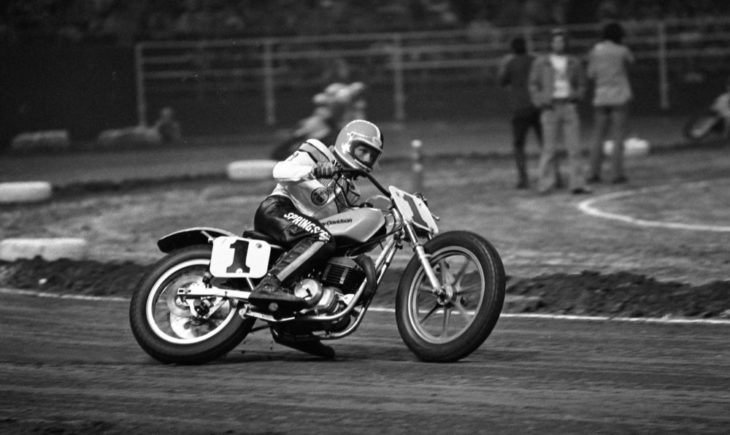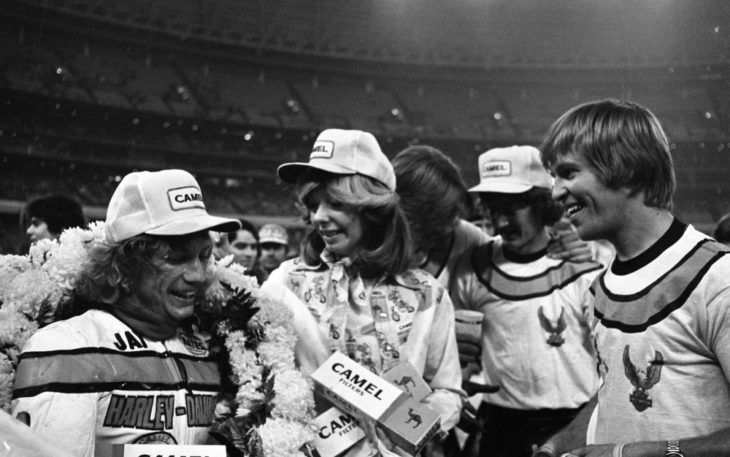Larry Lawrence | November 28, 2018
Archives: When Springsteen Ended a Harley Drought
Bultaco, Ossa, Yamaha and Honda. Those were four makes of motorcycles that won the 16 AMA Grand National Short Tracks from 1971 through 1976. Notice the most notable brand in flat track racing missing from that list? That’s correct – Harley-Davidson was shut out for seven years. From 1970 to 1977 Milwaukee iron went through an agonizingly long drought of national short track wins. That all changed at the Houston Short Track in 1977 thanks to the innovative tuning skills of Dick O’Brien, Bill Werner and the rest of Milwaukee’s racing crew and the not-too-shabby riding of legend in the making Jay Springsteen.
Archives: When Springsteen Ended a Harley Drought
 A good view of the Harley-Davidson MX250-based short tracker as Jay Springsteen races to victory at the Houston Short Track in 1977. (Gary Van Voorhis photo)
A good view of the Harley-Davidson MX250-based short tracker as Jay Springsteen races to victory at the Houston Short Track in 1977. (Gary Van Voorhis photo)
First, back to the beginning of the drought. In 1961 Harley-Davidson began importing an Italian-made 250cc four-stroke single Aermacchi machine. Harley named it the Sprint and began racing it with the designation CR250 (CRTT for the road racing version). In 1961 at Santa Fe Speedway, Carroll Resweber gave the new Sprint its first AMA Grand National victory. Throughout the rest of the ‘60s and into 1970, four-stroke Harley Sprints were used to win over half of the AMA Grand National Short Track races.
By the late 1960s with machines using two-stroke motocross engines, like the Bultaco, ridden by Ronnie Rall to victory at Houston in ’69 and the Ossa raced by Dick Mann at Santa Fe Speedway, it was clear that two-stroke engine builders were finally finding the low-end torque to give riders an advantage over those still using four-stroke racers. At Santa Fe Speedway in August of 1970, Bart Markel raced a Sprint to victory and that was it. After that the two-stroke era of short track racing took over.
As racing entered the middle of the 1970s, Harley-Davidson knew something had to be done. The Houston Short Track was part of the big season-opening doubleheader (along the TT National also held inside the Astrodome) and tens of thousands of fans attended. The race was a big deal and in the mid-1970s it was a bleak time at the event for factory H-D. In 1973 not one Harley made the made in the event. That was the first time that had happened since the race was inaugurated in 1968. Same thing happened in ’74. Then only a herculean effort by Corky Keener, put a Harley Sprint in the short track main in ‘75. He finished 10th.
By then Harley-Davidson figured if it couldn’t beat them it would join them, so the racing department began working on a short track machine powered by Harley’s MX-250 motocross powerplant (also an Aermacchi-built machine). According to factory tuner Bill Werner, one of the main reasons the MX-250 motocross machine was brought into the states was so the engine could be used in short track racing.
“When you’re battling Kenny Roberts, you can’t give away short track races. We were already hard pressed to get any points at the road races by this time, we couldn’t afford to give up points in short track too,” Werner explained. “The Italians were very talented when it came to two-stroke racing engines. We depended on them a lot for some of the components and initial engine set-ups. We modified them extensively for our purposes.
“Later on, there were two distinctly different paths we took [with the engine build] to compliment the riders’ different styles. Randy Goss had a different style from Jay [Springsteen] altogether. Randy liked the piston port engine where it had more peak power, but a narrower range. And he used a wider split between fourth and fifth [gear]. Jay used an engine with a little less peak power, but a wider [powerband] range. [For Jay’s] We grafted a Yamaha reed block onto the cylinder and used a narrower split between fourth and fifth, so when he shifted the rpm would be less of a differential, but it had the wider power band. Randy typically was a pole-putter and Jay was a high-liner. Those particular engines complimented both their styles.”
Even though the short track bike was raced so little, a great amount of development and modification went into the machines. To this day Werner recalls some of the details of what they did to optimize the MX250 engine for flat track racing.
“We converted them from Dell’Orto carbs to Mikuni. We make special air boots for the air filters… it was like a steel airbox rather than just clamping an air filter on. Designing the pipes had a lot to do with the power delivery.
And like most factory racing teams, Harley-Davidson’s squad spend a lot of time studying the AMA rulebook and optimizing, shall we say, engine design sometimes based on what wasn’t specified in the book, rather than what was.
“One of the, what you might call, sketchy way of doing it had to do with the rules indicating that you had to use a production-based cylinder head, but you could modify it any way you wanted. Our production cylinder heads didn’t have a lot of fins. Some of the top fins were cut off for the overhead up-pipe. That reduced the amount of fin area. An aftermarket company, Gilardoni, made a great radial fin head, but you couldn’t use it because it was an aftermarket head. But the rulebook said you could modify the stock head any way you wanted, so we took a Gilardoni head and bored it out and then took the stock head and essentially screwed the sparkplug section into the Gilardoni head. That was our modification,” Werner laughs. “So about two-square inches of it was stock Harley head and the rest of it was Gilardoni.
“It raised a bunch of eyebrows, but we did it within the rules. It just helped keep them a little cooler.”
By ’77 the bugs were worked out. In front of 38,365 fans, Springsteen passed Steve Morehead on the first lap and led the rest of the 25-lap main. A rules change for 1977 restricted short track entries to 250cc single-cylinder machines (it had previously allowed up to 360cc engines and 250cc two-stroke multi-cylinder machines). The new rules caused a flood of new entries at Houston, perhaps the most diverse in any AMA Grand National race. Ossa, Suzuki, Carabela, Montesa, Can-Am, Bultaco, Yamaha, KTM, Penton and Harley could all be seen on the 131-rider entry list that night. Five different engine brands were listed in the top 10 in qualifying with Hank Scott the fastest on a Shell Thuett Yamaha and Springsteen second. Springer ended up on the pole after winning the fastest of the six heat races.
 Jay Springsteen and factory tuner and builder Bill Werner are all smiles with Miss Camel after the seven-year short track win drought for Harley was broken. (Gary Van Voorhis photo)
Jay Springsteen and factory tuner and builder Bill Werner are all smiles with Miss Camel after the seven-year short track win drought for Harley was broken. (Gary Van Voorhis photo)
Behind winner Springsteen it was Ted Boody, who held off Kenny Roberts in a thrilling heat race, moved up to finish second, giving factory Harley a 1-2 finish. Mike Kidd took third on a Penton-powered machine set up in a KR chassis. It was a miracle for Kidd who was battling a severe case of stomach flu.
Springer would win it again in 1981 and ’82 with essentially the same bike, with a few differences, including a later move to a Champion frame.
In 1984 the short track rules changed again allowing 500cc four-stokes singles, rendering the Aermacchi 250cc two-strokes uncompetitive. The two-stroke era was largely over and over quickly. At the ’84 Houston Short Track National only one two-stroke qualified for the main – Terry Poovey, ironically on a Honda 250cc two-stroke. Randy Goss won on a Harley-Davidson certified Rotax-built 500cc four-stroke single.
The little Harley-Davidson two-stroke short track machines may go down in history as the most man hours re-engineering them for the fewest number of races entered for just about any racing motorcycle ever built.